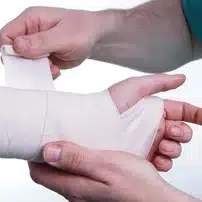Construction workers face more hazards because their environment poses significant safety risks. Some of the more common construction accidents leading to Workers’ Compensation claims involve electric shock, falls from ladders and scaffolding, being struck by objects, and serious hand injuries.
Hand injuries can be especially debilitating. Without the use of one’s hands, working and daily activities can be challenging. Without help from others, doing those things can even seem impossible.
Common work-related hand injuries include:
- Crush injuries: A construction worker’s hand can be crushed when it is caught between a rotating piece of equipment or two objects.
- Detachment: This is when a bone is forcibly pulled away from bone and tissue, and the worst-case scenario would be an amputation.
- Fractured bones: These can range from minor to severe and are categorized as simple or compound. The latter is more serious because the bones penetrate through the skin.
- Lacerations: Lacerations are common hand injuries that happen when the skin tears.
- Puncture wounds: Puncture wounds happen when objects break through the skin, and in some cases, exit through the opposite side.
- Medical imaging tests
- Surgery
- Follow-up appointments
- Medications
- Physical therapy
On top of that, people who cannot use a hand often need to hire help for assistance with cooking, cleaning, driving, and child care. Workers’ Compensation benefits can provide monies for the expenses.
What About Hand Injuries From Power Tools?
Federal Occupational Safety and Health Administration (OSHA) guidelines and some state labor laws set and enforce safety standards that should be followed when using dangerous machinery and tools.
There could be a third party responsible for your work-related hand injury. For example, a construction laborer who works for a plumbing contractor could be assigned to a general contractor that is not their employer. If that general contractor did not have the proper safety system in place, the injured laborer could have a case. Another example might be a manufacturer that made a defective power tool.
How Serious Are Hand Injuries?
This all depends on the nature of the injury. A minor fracture might warrant wearing a temporary splint and might not impact the worker’s activities that much. Other hand injuries can lead to a weakened grip, being unable to bend fingers, and a reduced range of motion. When an injury is significant, the worker might not be able to use the hand at all.
Even though the hand is a relatively small body part, the medical expenses for an injury to this part of the body can be high. A major laceration might cost around $10,000, but a severed tendon could be closer to $75,000. These costs could include:
Are Hand Injuries Common on Construction Sites?
More than 1 million American workers end up in emergency rooms each year because of serious hand and finger injuries. The Bureau of Labor Statistics (BLS) reports that the only injuries that lead to more lost days at work are ones involving the back. Many of these patients are construction workers because of the heavy, sharp, and motorized tools they use.
Out of the emergency room patients treated for hand injuries, approximately 70 percent had not been wearing gloves when they were injured. Besides that, about 30 percent were wearing them, but the gloves were either damaged or insufficient in another way. These percentages could be reduced if more construction workers kept their gloves on while working.
How Can Construction-Related Hand Injuries Be Prevented?
The best way to prevent hand and finger injuries is to wear appropriate construction safety gloves when working. These can be provided by employers, but many times, workers buy their own. Employers can require workers to wear gloves, and safety managers on construction sites can remind workers to put them on. Still, many forget to wear them or do not put them on because it impedes their work. Others wear damaged ones or pairs that do not fit properly.
The chances of hand injuries can be reduced by as much as 60 percent when workers wear the gloves suited for the work being performed. Modern technology has made them more sensitive to touch and more flexible, and there are different kinds designed for certain tasks. Site safety training is also important, with topics that should cover hand protection, personal protective equipment, first-aid procedures, and machine guards.
Wilmington Construction Injury Lawyers at Rhoades & Morrow Represent Construction Workers With Severe Hand Injuries
If you are dealing with a serious hand injury from a construction accident and need help with your claim, speak with one of our Wilmington construction injury lawyers at Rhoades & Morrow. To schedule a free consultation, complete our online form today or call us at 302-407-0827. We have offices in Wilmington, Bear, Milford, and Lewes, Delaware. With offices in all three counties of Delaware, we serve clients throughout the state.





